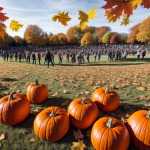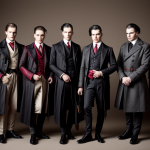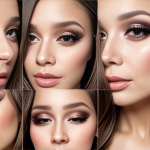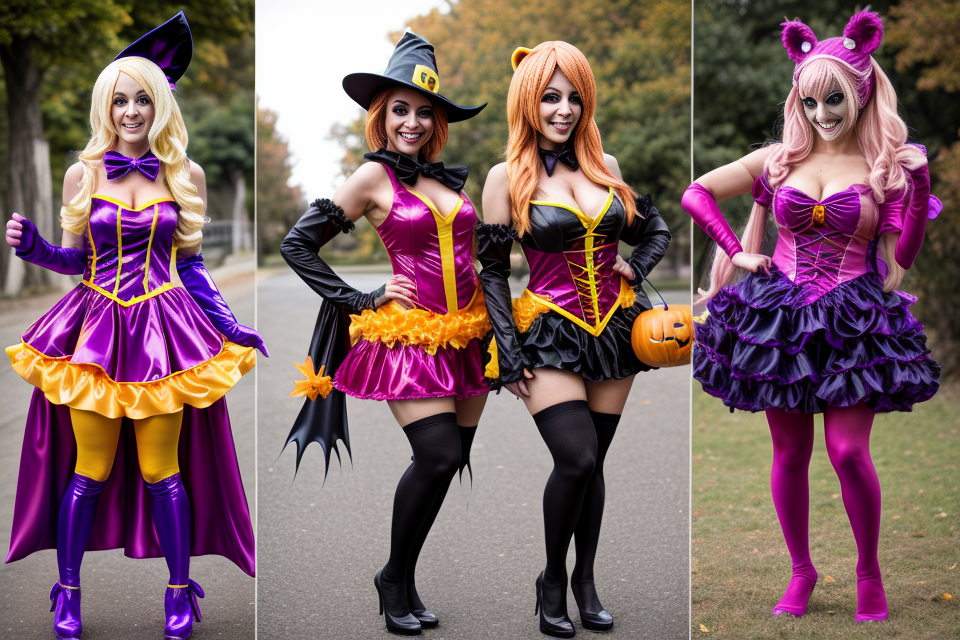=======================================================================
Halloween and cosplay are two different things, but they both involve dressing up in costumes. While Halloween is a holiday where people dress up in scary or spooky costumes, cosplay is a hobby where people dress up as their favorite characters from movies, TV shows, and video games. In this article, we will explore the differences between Halloween costumes and cosplay, and what makes them unique. So, get ready to learn all about the fascinating world of costumes and the fun of dressing up!
What is Halloween Costume?
Definition of Halloween Costume
- Halloween costume refers to a disguise or outfit worn during Halloween festivities.
- It is a traditional practice that originated in ancient Celtic harvest festivals, where people would dress up in costumes to ward off evil spirits.
- Halloween costumes are typically worn on October 31st, and the tradition is widely celebrated in the United States, Canada, the United Kingdom, and other countries.
- The costumes can be inspired by a wide range of sources, including movies, TV shows, comic books, and pop culture.
- Halloween costumes are typically made of inexpensive materials such as paper, cardboard, or plastic, and can be easily assembled by individuals.
- The purpose of wearing a Halloween costume is to have fun, be creative, and scare others.
- Children and adults alike enjoy dressing up in Halloween costumes, and many compete in costume contests to show off their creativity and skills.
Types of Halloween Costumes
When it comes to Halloween costumes, there are many different types to choose from. Here are some of the most common types of Halloween costumes:
- Traditional Costumes: These costumes are based on classic Halloween characters such as ghosts, goblins, and witches. They are often associated with the traditional image of Halloween and are popular among both children and adults.
- Movie/TV Show Costumes: These costumes are based on characters from movies or TV shows. They can range from superhero costumes to horror movie costumes and are popular among fans of specific movies or TV shows.
- Fictional Characters: These costumes are based on characters from books, comics, or video games. They can include popular characters such as superheroes, cartoon characters, or characters from fantasy novels.
- Historical Figures: These costumes are based on real-life historical figures. They can include famous figures such as Cleopatra, Napoleon, or Shakespeare, and are popular among those who want to learn about or celebrate history.
- Animal Costumes: These costumes depict animals, such as cats, dogs, or lions. They are often popular among children and can be either realistic or cartoonish in style.
What is Cosplay?
Definition of Cosplay
Cosplay, short for “costume play,” is a hobby where enthusiasts dress up as characters from various forms of pop culture, including manga, anime, video games, and more. This hobby involves more than just putting on a costume; it involves creating and wearing the costume, as well as adopting the persona and characteristics of the chosen character. Cosplayers often put a lot of time and effort into creating intricate costumes and perfecting their character’s mannerisms, making it a unique and immersive experience for both the cosplayer and the audience.
Differences Between Cosplay and Halloween Costumes
- Cosplay is not limited to Halloween:
- While Halloween costumes are typically worn only on October 31st, cosplay can be worn at any time of the year and is not limited to a specific event. This means that cosplayers can express their love for a particular character or franchise whenever they want, not just once a year.
- Additionally, cosplayers often attend conventions and other events where they can show off their costumes and interact with other fans. These events can range from small, local gatherings to large, international conventions like Comic-Con or Anime Expo.
- Cosplay involves a deeper level of commitment:
- Cosplayers often go to great lengths to accurately portray their chosen character, including creating their own costumes and props from scratch. This can involve a lot of time, effort, and skill, as well as a deep understanding of the source material.
- In contrast, Halloween costumes are often pre-made or purchased, and may not require as much creativity or craftsmanship.
- Cosplay is often more creative:
- Because cosplayers are creating their own costumes and accessories, there is a lot of room for creativity and originality. Cosplayers may put their own spin on a character’s design, or create entirely new costumes based on their own ideas.
- In contrast, Halloween costumes are often more standardized and based on pre-existing designs.
- Cosplay is a form of self-expression:
- Many cosplayers choose characters that resonate with them on a personal level, and use cosplay as a way to express their creativity and fandom. This can include not just the costume itself, but also the way the cosplayer acts and behaves while in character.
- For some cosplayers, the process of creating and wearing a costume is a deeply personal and meaningful experience. In contrast, Halloween costumes may be chosen more for their novelty or comedic value.
Halloween Costumes vs. Cosplay
Similarities
Both Halloween costumes and cosplay involve dressing up as characters from pop culture. This shared characteristic is often the primary similarity between the two. It allows individuals to tap into their creativity and express themselves in a fun and imaginative way.
Additionally, both Halloween costumes and cosplay can be a form of self-expression. They allow people to showcase their interests, personality, and creativity. This shared aspect can be particularly appealing to those who enjoy dressing up and immersing themselves in the world of their favorite characters.
Moreover, both Halloween costumes and cosplay can be a social activity. They provide an opportunity for people to gather together, whether it’s for a party or a convention, and share their passion for pop culture. This shared aspect can help to foster a sense of community and belonging among those who participate in these activities.
However, despite these similarities, there are also important differences between Halloween costumes and cosplay that set them apart from one another. These differences include the level of detail and accuracy, the level of commitment, and the context in which they are worn. Understanding these differences can help to clarify the unique characteristics of each activity and why they appeal to different people in different ways.
Differences
Purpose
While Halloween costumes are typically worn for a one-time event, such as a party or trick-or-treating, cosplay can be a year-round hobby. Cosplayers often choose to portray their favorite characters from movies, TV shows, video games, or comic books, and may attend conventions or events specifically to showcase their costumes and meet other fans.
Level of commitment
Halloween costumes are often pre-made or purchased, while cosplay often involves creating the costume and accessories from scratch. This requires a higher level of skill and dedication, as well as the ability to source or create materials and props. Cosplayers may also spend a significant amount of time researching and studying the characters they want to portray in order to accurately capture their look and personality.
Audience
Halloween costumes are typically worn for parties or trick-or-treating, where the focus is on the spooky or playful nature of the holiday. Cosplay, on the other hand, is often performed at conventions or events where fans of a particular series or franchise gather. This allows cosplayers to showcase their costumes and interact with other fans in a more immersive and meaningful way.
Overall, while Halloween costumes and cosplay may both involve dressing up as characters, they are distinct activities with different purposes, levels of commitment, and audiences.
Popular Characters for Halloween Costumes and Cosplay
Halloween Costumes
- Classic Characters: Includes ghosts, goblins, witches, and other traditional Halloween characters.
- Ghosts: These characters often feature a white sheet with two eyeholes and are designed to resemble the classic depiction of ghosts.
- Goblins: Goblins are often depicted as small, mischievous creatures with green skin, pointed ears, and large teeth.
- Witches: Witches are often depicted as older women with long noses, pointed hats, and black clothing.
- Horror Characters: Includes characters from horror movies or TV shows, such as zombies, vampires, or serial killers.
- Zombies: Zombies are often depicted as shuffling, mindless creatures with pale skin, sunken eyes, and tattered clothing.
- Vampires: Vampires are often depicted as suave, charismatic characters with pale skin, sharp teeth, and a thirst for blood.
- Serial Killers: Serial killers are often depicted as disturbing, unhinged characters with dark clothing and twisted motivations.
- Pop Culture Characters: Includes characters from movies, TV shows, or music videos that are popular at the time.
- Superheroes: Superheroes are often depicted as heroic figures with colorful costumes and extraordinary abilities.
- Cartoon Characters: Cartoon characters are often depicted as cute, animated creatures with bright colors and expressive faces.
- Film Characters: Film characters are often depicted as iconic figures from popular movies, such as sci-fi heroes or fantasy warriors.
Cosplay
- Anime/Manga Characters: Includes characters from Japanese anime and manga series, such as Naruto, Dragon Ball, or Attack on Titan. These characters are often highly stylized and feature unique, colorful costumes and intricate details. Many cosplayers enjoy embodying these characters because they often have complex backstories and personalities that can be brought to life through performance and interpretation.
- Video Game Characters: Includes characters from popular video games, such as Mario, Zelda, or Fortnite. These characters are often action-oriented and feature recognizable outfits and accessories. Cosplayers may choose to create detailed replicas of the characters’ clothing and weapons, or they may take a more creative approach and incorporate their own interpretations and ideas into their costumes.
- Comic Book Characters: Includes characters from Marvel, DC, or other comic book series. These characters are often iconic and well-known, with distinctive looks and personalities. Cosplayers may choose to create costumes that closely resemble the characters’ comic book appearances, or they may put their own spin on the characters’ styles and create unique, original designs.
In general, cosplayers often enjoy creating intricate and detailed costumes that accurately represent their chosen characters. They may spend hours or even months working on their costumes, sewing, crafting, and assembling all of the necessary pieces. Cosplayers often enjoy dressing up as their favorite characters for conventions, fan events, or just for fun. They may also enjoy sharing their costumes and creations with others online, through social media or cosplay-focused websites and forums.
Tips for Choosing a Halloween Costume or Cosplay Character
Consider Your Skills and Resources
When choosing a character for your Halloween costume or cosplay, it’s important to consider your skills and resources. Here are some tips to help you make the right choice:
- Evaluate Your Skills: The complexity of a costume can vary greatly depending on the character. For example, a superhero costume may require more sewing and construction skills than a simple mask and cape. If you’re new to cosplay, it’s best to start with a simpler character and work your way up to more complex ones.
- Assess Your Resources: Depending on the character you choose, you may need to gather specific materials or props. If you’re on a tight budget, you may want to choose a character whose costume can be made using materials you already have on hand. You should also consider whether you have access to the necessary tools and equipment to create the costume.
- Consider the Time Commitment: Creating a cosplay costume can be a time-consuming process, especially if you’re making it from scratch. Before choosing a character, consider how much time you have available to work on the costume. If you’re short on time, you may want to choose a character with a simpler costume or one that you can purchase off-the-rack.
- Think about Your Comfort Level: Some costumes can be heavy, hot, or uncomfortable to wear. If you’re planning to wear your costume for an extended period of time, you’ll want to choose a character whose costume is comfortable and easy to move in. You should also consider whether the costume will be appropriate for the event or venue you’ll be attending.
By taking these factors into account, you can choose a character that’s well-suited to your skills, resources, and preferences. With careful planning and attention to detail, you can create a cosplay costume that’s both impressive and enjoyable to wear.
Choose a Character That Resonates with You
Choosing a character that resonates with you is crucial when it comes to selecting a Halloween costume or cosplay character. Here are some tips to help you make the right choice:
- Consider Your Passions: Think about the things that you are passionate about, whether it’s a particular movie, book, or video game. Choosing a character from one of these sources can make your costume or cosplay feel more personal and meaningful.
- Explore Different Characters: Don’t be afraid to try out different characters to find the one that resonates with you the most. You might be surprised by how much you connect with a character that you didn’t initially consider.
- Think About the Character’s Backstory: Characters with complex backstories can provide more opportunities for creative expression and exploration. Consider how the character’s history can inform their appearance, behavior, and motivations.
- Consider the Costume’s Appearance: The appearance of the costume can also play a role in choosing a character. Some costumes might be more challenging to create than others, so consider your skills and resources when selecting a character.
- Choose a Character That Fits Your Body Type: Choosing a character that fits your body type can help you feel more confident and comfortable in your costume. Avoid choosing characters that are too skinny or too muscular if it doesn’t align with your body type.
By choosing a character that resonates with you, you can create a more authentic portrayal of the character and make the experience more enjoyable.
Consider the Audience
When choosing a Halloween costume or cosplay character, it’s important to consider the audience you will be presenting to. Here are some key factors to keep in mind:
- Age Appropriateness: Make sure the costume or character is appropriate for the age group of the audience. For example, a children’s party may call for a more family-friendly costume, while a cosplay convention may allow for more mature themes.
- Cultural Sensitivity: Be mindful of cultural sensitivities and avoid costumes or characters that may be considered offensive or insensitive. It’s important to respect and appreciate the diversity of different cultures and communities.
- Setting: Consider the setting in which you will be wearing the costume or portraying the character. For example, a costume party may allow for more creative and outlandish costumes, while a formal event may require a more subdued and sophisticated look.
- Personal Comfort: Make sure the costume or character is comfortable for you to wear and portray. A costume that is too tight or uncomfortable can detract from the overall experience and may even cause physical discomfort.
By considering the audience, you can ensure that your Halloween costume or cosplay character is appropriate, respectful, and enjoyable for all involved.
FAQs
1. What is Halloween costume?
Halloween costume refers to the attire worn during the Halloween festival, typically characterized by spooky and scary themes. People wear these costumes to dress up as their favorite characters, or to portray a specific theme or idea. Halloween costumes are often simple and easy to make, and are worn only on the night of Halloween or during Halloween-themed parties.
2. What is cosplay?
Cosplay, short for “costume play,” is a hobby where people dress up as their favorite characters from manga, anime, video games, movies, or TV shows. Cosplayers often put a lot of effort into creating detailed and accurate costumes, and may also adopt the mannerisms, speech, and other characteristics of the characters they are portraying. Cosplay is not limited to any specific event or time of the year, and can be practiced by people of all ages and backgrounds.
3. What are the differences between Halloween costumes and cosplay?
The main difference between Halloween costumes and cosplay is the context and purpose of wearing them. Halloween costumes are worn only on Halloween or during Halloween-themed parties, while cosplay can be practiced at any time of the year. Halloween costumes are typically simpler and less detailed than cosplay costumes, and are often bought off the rack or easily made at home. Cosplay costumes, on the other hand, are often more elaborate and require more time and effort to create, with attention paid to even the smallest details. Additionally, while Halloween costumes are usually associated with spooky and scary themes, cosplay can encompass a wide range of genres and styles.
4. Can I wear a Halloween costume for cosplay?
Technically, you can wear a Halloween costume for cosplay, but it may not be well-received by the cosplay community. Cosplay is all about creating an accurate and detailed representation of a character, and a Halloween costume may not meet those standards. Additionally, many Halloween costumes are mass-produced and not very unique, which can detract from the creativity and craftsmanship that is often celebrated in cosplay. If you want to cosplay, it’s best to create or find a costume that is specifically designed for that purpose.









